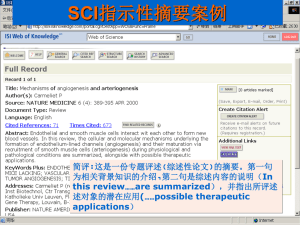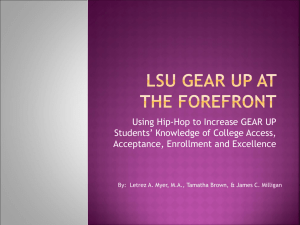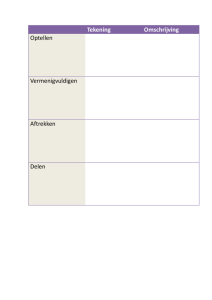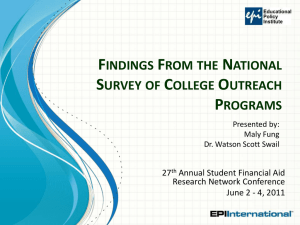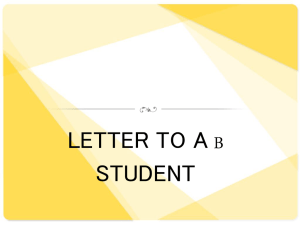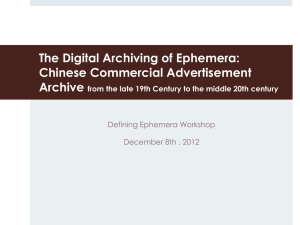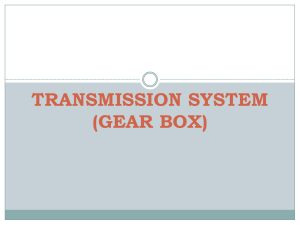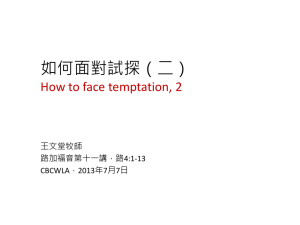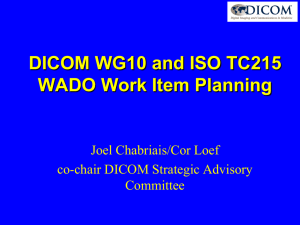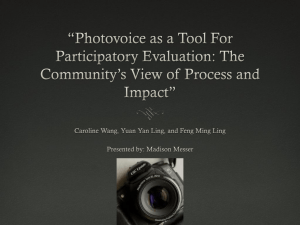科技论文的结构
advertisement
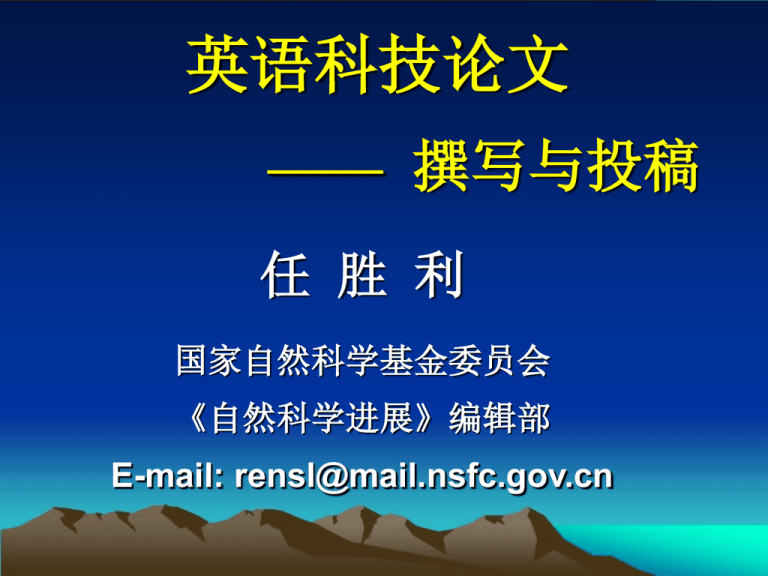
英语科技论文 —— 撰写与投稿 任 胜 利 国家自然科学基金委员会 《自然科学进展》编辑部 E-mail: rensl@mail.nsfc.gov.cn 主要参阅资料 1. 任胜利. 英语科技论文撰写与投稿 (书) 2. 马新亮. Smart Writing 3.李 婴. 英文论文写作及投稿技巧讲座 4.马 兰. Figure it early, Figure it right & Figure it out 5. Lambers H. Preparing your results for publication 6. Cook N J. Preparation, submission and publishing of scientific manuscripts in international journals 7. http://www.dxy.cn/bbs/post/page?bid=45&sty=1&age=0 英语科技论文: 撰写与投稿 1 写作前的准备 2 论文的结构安排与撰写 3 科技英语的文法与表达 4 投稿及与编辑的联系 为什么要发表论文? Publish or perish (发表或者灭亡) — 科研成果:如果没有发表,就等于不曾存在; — 科研人员:没有论著发表,职业生涯将难以为继 There are three necessary steps in useful research: the first to begin it, the second to end it and the third to publish it. —— M. Faraday 应该发表什么样的科技论文? 一点之见即成文; 避免无意或有意的剽窃行为(即: 引述他人思想、 数据或论述而不注明出处); 避免一稿多投或一稿多发; 抄一篇为剽窃,抄多篇为创新 科技英文写作与讲演 寻找创建模板的论文 — 发表于国际知名期刊; — 最近3-5年内发表; — 至少有一位英语母语的作者 创建模板 — 句子的结构、长度、句式变化; — 动词、转接词、介词的使用; — 动词时态; — 怎样开始和结束; — 如何及何时承认他人的贡献 适度模仿 建立语料库 阅读“作者须知”或“投稿指南” 刊物的宗旨和范围; 各栏目论文的长度、章节的顺序安排, 等; 采取何种体例格式? 如: 页边距、纸张大小、 参考文献的体例、图表的准备、等; 履行何种形式的同行评议? 多长时间后能决定可否录用 英语科技论文: 撰写与投稿 1 写作前的准备 2 论文的结构安排与撰写 3 科技英语的文法与表达 4 投稿及与编辑的联系 科技论文的结构 论文题名+眉题 作者姓名+通讯地址 摘要+关键词 引言(Introduction) 材料与方法(Materials and methods) 结果(Results) 讨论与结论(Discussion & Conclusion) 致谢 参考文献 Where do I start? 科技论文的结构: 主体部分 引言 (Introduction) 材料与方法 (Materials and methods) 结果 (Results) 讨论与结论 (Discussion & Conclusion) Introduction:写作内容 综述研究背景:概述本项工作的研究或观察的理论基 础,给出简明的理论或研究背景,一定要列举重要的 相关文献; 指出存在问题:说明为什么要做这项工作; 阐述研究目的:说明有别于他人的“主意” (Write for a range of interested scientists) “引言”要与“讨论”形成“呼应”关系 (Use your Discussion as a guideline) 引言:注意事项 应引用“最相关”的文献以指引读者. 力戒刻意回避 引用最重要的相关文献; 避免不恰当地大量引用作者本人的文献; 解释或定义专门术语或缩写词, 以帮助编辑、审稿人 和读者阅读与理解; 叙述前人工作的欠缺以强调自己研究的创新时, 应慎 重且留有余地(避免“首次提出”、“重大发现”, 等) ——To the author’s knowledge… / There is little information available in literature about…;等等 科技论文的结构: 主体部分 引言 (Introduction) 材料与方法 (Materials and methods) 结果 (Results) 讨论与结论 (Discussion & Conclusion) Materials and methods: 写作内容 明确描述实验对象和方法的选择, 医学论文中 还应说明实验过程是否符合伦理学要求; 详细描述实验方法和实验步骤; 列举建立方法的参考文献,并做简要描述(但 不需全部重复描述); 如果对已有方法进行了新的或实质性的改进, 就要清楚地说明改进的理由 材料与方法: 英文表达 不可遗漏动作的执行者: ——To determine its respiratory quotient, the organism was… (the organism determine…?) ——Having completed the study, the bacteria were of no further interest. (the bacteria completed the study?) 文献引用尽量准确、具体: ——cells were broken by as previously described[9] 应改 为:cells were broken by ultrasonic treatment as previously described[9]. 科技论文的结构: 主体部分 引言 (Introduction) 材料与方法 (Materials and methods) 结果 (Results) 讨论与结论 (Discussion & Conclusion) Results:总体要求 对实验或观察结果的表达要高度概括和提炼 (按逻辑顺序描述或总结重要的观察结果); 数据表达可采用文字与图表相结合的形式 (避免使用文字、图、表重复同一数据); 尽可能列出“结果”的原始数据,而不能只 报道统计处理后的数据 The choice between a Figure or a Table 表格:很方便地列举大量精确数据或资料; 图形:直观、有效地表达复杂数据,尤其是 不同组数据间的比较、关联、趋势等; 表格和图形应具有“自明性” ; 图表题名:准确而清楚地表达出数据或资料 的含义, 切忌简单地描述数据 — 图表是论文中的空白处 (blank area) 表格的修改 Type of attack Classical Pop Jazz Echo addition 0.0% 0.1% 0.27% Noise Addition 1.2% 1.42% 1.6% Band equalization 2.31% 2.5% 2.73% 三线表 / 共用单位 / 有效数字 Type of attack Classical (%) Echo addition Noise addition Band equalization 0 1.20 2.31 Pop (%) 0.10 1.42 2.50 Jazz (%) 0.27 1.60 2.73 插图的制作 不要因追求美术效果而将图形做得过于花哨 (如增加不必要的阴影或立体效果等); 坐标图的标值应尽量取0.1–1000之间的数值; 坐标轴的说明应清楚, 量和单位缺一不可 照片图必须具备高清晰度,显微照片的放大倍 数应使用图示法(标尺刻度)表示,照片中的符 号、字母、数字等,必须在图注中详细说明 无需使用色彩 显微照片: 清晰 明亮 对比度 字体、字号一 致 图题与表题的撰写 JBC,2001,276: 4709-4716 科技论文的结构: 主体部分 引言 (Introduction) 材料与方法 (Materials and methods) 结果 (Results) 讨论与结论 (Discussion & Conclusion) Discussion - 讨 论 “讨论”的重点在于对研究结果 的解释和推断, 并说明作者的结 果是否支持或反对某种观点、是 否提出了新的问题或观点等; 撰写讨论时要避免含蓄, 尽量做 到直接、明确, 以便审稿人和读 者了解论文为什么值得引起重视 (Place your results in a wider context) “Selling” my data! 讨论:基本内容 对结果提出说明、解释或猜测; 根据这些结果, 能得出何种结论或推论? 指出研究的局限性以及这些局限对研究结果 的影响; 并建议进一步的研究题目或方向; 指出结果的理论意义(支持或反驳相关领域中 现有的理论、对现有理论的修正)和实际应用 讨论:注意事项 对结果的解释要重点突出, 简洁、清楚:着重讨论本 研究的重要发现,以及由此得出的结论,不要过细 地重复引言或结果中的数据或资料; 推论要符合逻辑, 避免实验数据不足以支持的观点和 结论; 对结果的科学意义和实际应用的表达要实事求是, 适 当留有余地; 讨 论 的 最 后 最 好 是 论 文 的 最 重 要 的 结 论 (take- home-message) 讨论:时态 现在时:具有普遍的意义推论或结论: ——The experimental and theoretical values for the yields agree well. ——Our data suggest that the reaction rate may be determined by the amount of oxygen available. 过去时:所概述推论的有效性只是针对本次特定 的研究: ——In the first series of trials, the experimental values were all lower than the theoretical predictions. Conclusion - 结 论 有时也可将“结论”单独列为一节 (通常可包 括在“讨论” 或“结果与讨论”中); “结论”中的基本内容: 作者本人研究的主要认识或论点; 总结性地阐述本研究结果可能的应用前景、研究 的局限性及需要进一步深入的研究方向; 结论中不应涉及新的事实, 也不能简单地重复摘 要、引言、结果或讨论等章节中的句子 科技论文的结构 论文题名+眉题 作者姓名+通讯地址 摘要+关键词 引言(Introduction) 材料与方法(Materials and methods) 结果(Results) 讨论与结论(Discussion & Conclusion) 致谢 参考文献 Where do I start? 科技论文的结构: 篇前部分 论文题名+眉题 (Running Title) 作者姓名+通讯地址 摘要+关键词 Title 题名 以最少数量的单词来充分表述论文的内容 题名的作用 吸引读者. 题名相当于论文的“标签”(label), 题 名如果表达不当, 就会失去其应有的作用, 使真正需 要它的读者错过阅读论文的机会; 帮助文献追踪或检索. 文献检索系统多以题名中 的主题词作为线索, 因而这些词必须要准确地反映 论文的核心内容, 否则就有可能产生漏检 题名: 基本要求 准确(Accuracy):准确地反映论文的内容; 简洁(Brevity): 中文最好不超过20个汉字,英文 最好不超过10 – 12个单词; 清楚(Clarity): 清晰地反映文章的具体内容和特 色, 力求简洁有效、重点突出 尽可能将表达核心内容的主题词放在题名开头; 慎重使用缩略语; 避免使用化学式、上下角标、特殊符号(数字符号、希腊 字母等)、公式等; 避免使用Thoughts on ..., Regarding …, Study…, 等 论文题名举例 Bad: Action of antibiotics on bacteria Bad: Preliminary observations on the effect of certain antibiotics on various species of bacteria Good: Action of Streptomycin on Mycobacterium tuberculosis Better: Inhibition of growth of Mycobacterium tuberculosis by Streptomycin 论文题名举例:介词问题 Bad: Linear programming method of optimization of systems of partial differential equation Good: Linear programming method for optimization of partial differential equation systems (偏微分方程系统最优化的线性程 序设计方法) Bad: Formulation of equations of vertical motion of finite element form for vehicle-bridge interaction system Good: Finite element based formulations for vehicle-bridge interaction system considering vertical motion 车桥相互作用系统有限元形式的竖向运动方程 论文题名举例: 缩略语的使用 The effects of air pollutants on taking of SARS GEE 用广义估计方程研究大气污染对SARS发病的影响 GEE—generalized estimating equation The quarantine measures and preventative countermeasures of preventing the propagation of RIFA through international shippings 防止红火蚊随国际航行船舶传播的检疫措施与防控对策 RIFA—red imported fire ant 题名类型 名词词组: Inositol trisphosphate and calcium signaling (三 磷酸肌醇和钙信号表达 ) 主副题名: WAF1:A potential mediator of p53 tumor suppression (WAF1: p53肿瘤抑制作用的一个可能介导因子) 系列题名: Density-functional thermochemistry. III. The role of exact exchange (密度函数的热化学: 3. 正解交换的作用) 陈述性题名: The p21 Cdk-interacting protein Cip1 is a potent inhibitor of G1 cyclin-dependent kinases (p21 Cdk作 用蛋白(又称Cip1)是G1细胞周期依赖性蛋白激酶的强抑制剂) 疑问句题名: When is a bird not a bird? Running Title (眉题) 用于论文的页眉 是论文题名的缩写,一般不超过40个字符 应包含论文中最核心的内容 期刊的习惯 Running Title:举例 题目:WAF1: p53肿瘤抑制作用的一个可能介导因子 WAF1:A potential mediator of p53 tumor suppression 眉题:WAF1 as a mediator of p53 function 题目:淋巴细胞再循环和白细胞迁移中的路径信号: …… Traffic signals for lymphocyte recirculation and leukocyte emigration: the multistep … 眉题:Traffic signals for leukocyte circulation 科技论文的结构: 篇前部分 论文题名+眉题 作者姓名+通讯地址 摘要+关键词 Who are the authors? 国际医学期刊编辑委员会(ICMJE)有关作者资 格的界定: (1) 课题的构思与设计,资料的分析和解释; (2) 文稿的写作或对其中重要学术内容作重大修改; (3) 参与最后定稿,并同意投稿和出版 — 以上3项条件应全部具备方可成为作者; 作者的 排列顺序应由所有作者共同决定; 每位作者都应该 能够就论文的全部内容向公众负责 Who is the first author? 论文的执笔人或主要撰写者应该是第一作者; 贡献相同作者的表达: — 共同第一作者, — 通 讯 作 者 (To whom correspondence should be addressed / Correspondence author), — 这些作者对研究工作的贡献是相同的 避免“搭车”署名、不能遗漏应该署名的作者、不可 擅自将知名人士署为作者之一以提高论文声誉和影响 作者姓名的拼音表达方式 国家标准(GB/T 16159-1996) : 汉语人名按姓和名 分写, 姓和名的开头字母大写, 如: Wang Jianguo (王 建国), Dongfang Shuo (东方朔), Zhuge Kongming (诸 葛孔明), 等; “中国学术期刊(光盘版)检索与评价数据规 范” :姓前名后, 姓氏的全部字母均大写, 复姓应连 写. 名字的首字母大写, 双名中间加连字符; 名字不缩 写. 如: ZHANG Ying (张颖), WANG Xi-lian (王锡联), ZHUGE Hua (诸葛华) 作者姓名的拼音表达方式 国外期刊一般会尊重作者对自己姓名的表达方式(但 大多倾向于大写字母只限于姓和名的首字母); 发表于“Nature”(2002, 415: 732)的一篇短文中3位 作者姓名的表达分别为 Shengli Ren, Guang’an Zu, Hong-fei Wang (任胜利, 祖广安, 王鸿飞) 缩写: Ren S, Zu G, Wang H F 应尽量采用相对固定的英文姓名的表达形式, 以减少 在文献检索和论文引用中被他人误解的可能性 作者地址的标署 尽可能地给出详细的通讯地址; 如果论文出版时作者调到一个新的地址, 新 地址应以“Present address”(现地址)的形式 在脚注中给出; 如果第一作者不是通讯作者, 作者应按期刊 的相关规定表达, 并提前告诉编辑. 期刊多以 星号(*)、脚注或致谢的形式标注通讯作者或 联系人 科技论文的结构: 篇前部分 论文题名+眉题 作者姓名+通讯地址 摘要+关键词 Abstract 摘 要:以提供文献内容梗概为目的, 不加评论和补 充解释, 简明、确切地记叙文献重要内容的短文; 摘要的类型 (1) 报道性摘要: 全面、简要地概括论文的目的、方法、主 要数据和结论. 结构式摘要 (2) 指示性摘要:只简要概括论文的主题; (3) 报道-指示性摘要: 以报道性摘要的形式表述论文中的 信息价值较高的部分, 以指示性摘要的形式表述其余部分 Structured Abstract (结构式摘要) 是报道性摘要的结构化表达 (1) 目的(Objective): 研究的问题、目的或设想等; (2) 设计(Design): 研究的基本设计, 样本的选择; (3) 单位(Setting): 开展研究的单位; (4) 对象(Patients, Participants): 研究对象的信息; (5) 处置(Interventions): 处置方法; (6) 主要结果测定(Main Outcome Measures): 实验过程; (7) 结果(Results): 研究的主要发现; (8) 结论(Conclusions): 主要结论及其潜在应用 结构式摘要的类型 New England Journal of Medicine Background, Methods, Results, Conclusions The Lancet Background, Methods, Findings, Interpretation JAMA Context, Objective, Design, Setting, Patients, Interventions, Main Outcome Measures, Results, Conclusion 摘要:撰写技巧 (1) 应大致包括IMRD 结构的论文写作模式; 使用简短的句子, 用词应为潜在读者所熟悉; 注意表述的逻辑性, 尽量使用指示性的词语来 表达论文的不同部分(层次) — 如使用“研究表明…”(We found that…)表示结 果; 使用“通过对...的分析,认为 …”(Based on…, we suggest that…)表示讨论等 摘要:撰写技巧 (2) 确保摘要的“独立性” 或“自明性”: 尽量 避免引用文献、图表和缩写; 尽量避免使用化学结构式、数学表达式、角 标和希腊文等特殊符号; 可适当强调研究中的创新、重要之处; 尽量 包括论文的主要论点和重要细节(重要的论 证或数据) Despite the remarkable thermochemical accuracy of Kohn-Sham density-functional theories with gradient corrections for exchange-correlation [see, for example, A. D. Becke, J. Chem. Phys. 96, 2155 (1992)], we believe that further improvements are unlikely unless exactexchange information is considered. Arguments to support this view are presented, and … 报道+ 指示性摘要 Keywords (关键词) 不要使用过于宽泛的词做关键词(例如:有机 化合物,生态科学,等等),以免失去检索的 作用; 避免使用自定的缩略语、缩写字作为关键词, 除非是科学界公认的专有缩写字(如: DNA); 关键词的数量要适中 科技论文的结构 论文题名+眉题 作者姓名+通讯地址 摘要+关键词 引言(Introduction) 材料与方法(Materials and methods) 结果(Results) 讨论与结论(Discussion & Conclusion) 致谢 参考文献 Where do I start? 科技论文的结构: 篇尾部分 致 谢 (Acknowledgements) 参考文献 (References) Acknowledgements 对于不够署名条件, 但对研究成果确有贡献者, 可以 “致谢”的形式列出, 作为致谢的对象通常包括: — 协助研究的实验人员; — 为研究提供方便(仪器、测试等) 的机构或人员; — 提出过指导性意见的人员; — 资金资助项目或类别(但不宜列出得到经费的数量) 致谢:尽量具体、如实 应尽量指出致谢对象的具体帮助与贡献; 致谢某人可能暗含着某人赞同论文的观点或 结论: 如果被感谢的人并不同意论文的全部 观点或结论, 那么论文公开后被感谢的人和 作者都会很尴尬; 表示应有的礼貌和尊重: 投稿前应请所有被 感谢的对象阅读论文的定稿(尤其要包括 “致谢”部分), 以获得允许或默认 致谢:用词要恰当 致 谢 的 开 始 就 用 “ We thank”, 不 要 使 用 “We wish to thank”, “We would like to thank”, 等; 如果说“I wish to thank Jones for …”则是在浪费 单词, 并且也可能蕴含着我希望感谢John Jones的帮 助, 但这种帮助并不那么大); 用“I thank Jones”更显得简明和真诚 科技论文的结构: 篇尾部分 致 谢 (Acknowledgements) 参考文献 (References) References:基本原则 所选用文献的主题必须与论文密切相关; 必须是亲自阅读过; 优先引用论文: 最新发表/特定期刊/特定作者; 避免过多的作者自引; 遵循拟投稿期刊的体例要求; 确保文献各著录项(作者姓名, 等)正确无误 论文题目, 期刊或专著名, 参考文献的体例类型 有250种以上的参考文献列举形式 (著录项的取舍、 著录项的编排顺序、字体变化、标点符号等方面); 正文中参考文献的标注类型: 著者-出版年体系(name - year system,N-Y); 顺序编码体系(citation - order system或citation sequence system,C-S); 著者-数字(顺序编码)体系(alphabet - number system,A-N) Worldwide research on pegmatites has involved the study of their petrogenesis (Solodov, 2002), classification (Cerny and Lenton, 1995), texture and structure (Zou et al., 2004), rare element geochemistry (Li, 1982a, 1982b, 1991), mineralogy (Roedder, 1984), and experimental petrology (Bai, 1995; Zeng and Jin, 1995; Wu et al., 1995). References Bai CH… 1995… Cerny L, and Lenton…1995… … Wu GH, Hu CH, Roedder H…1995… Zou AQ, Han AH, Chen AF…2004… 著者-出版年体系 Worldwide research on pegmatites has involved the study of their petrogenesis[1], classification[2], texture and structure[3], rare element geochemistry[4-6], mineralogy[7] and experimental petrology[8-10] . References 1. Solodov F…2002 … 2. Cerny L, and Lenton…1995… 顺序编码体系 … 9. Zou AQ, Han AH, Chen AF…2004… 10. Wu GH, Hu CH, Roedder H…1995… Worldwide research on pegmatites has involved the study of their petrogenesis[7], classification[2], texture and structure[10], rare element geochemistry[3-5], mineralogy[6] and experimental petrology[1,9,8] . References 1. Bai CH… 1995… 2. Cerny L, and Lenton…1995… … 7. Solodov F…2002 … … 9. Wu GH, Hu CH, Roedder H…1995… 10 Zou AQ, Han AH, Chen AF…2004… 著者-数字体系 Long ‘strings’ of references are not helpful if given without any kind of context. Worldwide research on pegmatites has involved the study of their petrogenesis, classification, texture and structure, rare element geochemistry, mineralogy, and experimental petrology (Solodov, 1962; Zou and Xu, 1975; Zou et al., 1986; Kuzminko, 1976; Makagon, 1977; Makagon and Shmakin, 1988; Luan, 1979; Wang, 1982; Shmakin, 1983; London, 1981, 1986, 1998; Cerny, 1982a, 1982b, 1991; Cerny et al., 1986; Cerny and Lenton, 1995; Roedder, 1984; Walker et al., 1986; Wang et al.,1987; Chu and Wang, 1987; Wang et al.,1987; Zhang et al., 1987; Zhao et al., 1993; Li et al.,1983; Li ,1987; Li et al.,1994, 1998, 1999a, 1999b, 2000; Bai, 1995; Zeng and Jin, 1995; Wu et al., 1995; Lu and Wang,1997; Feng, 1998). 36 references in one sentence! Better would be give just 2-3 pertinent references in a proper context. Take special care when citing papers that are contained in books or other non-serial publications. Details of the Editor and Publisher should always be given. Huang, Z.L., Han, R.S., Chen, J., Li, W.P., Xu, C., 2001. Oreforming element contents of the periphery strata of the Huize PbZn mine and Emeishan basalts and their significance. In: Hu, R.Z., Bi, X.W. (Eds.), Annual Report of the Open Lab. of Ore Deposit Geochemistry, Chinese Academy of Sciences, Guizhou Science and Technology Publishing House, Guiyang, p. 99-103. (in Chinese with English abstract). Publications in Chinese should be indicated. Always give the original title of publications in other languages using the French, German, Spanish, Portuguese etc., but the translated title of titles written in other alphabets (e.g. Russian, Japanese) Brandenstein, M., Janda, L., Schroll, E., 1960. Seltene Elemente in österreichischen Kohlen- und Bitumengesteinen. Tschermaks Mineralogisch-Petrographische Mitteilungen 7, 260-285. Barca, S., Eltrudis, A., 1994. Attribution à l’Eocarbonifère de flysch des nappes inférieures “à marbres” du Sud-Est de la Sardaigne (Italie). Comptes Rendus de l'Académie des Sciences 319 (II), 1407-1414. Denisova, E.A., 1985. The deformation history of Nurali ultrabasic massif (South Urals). Izvestia Akademy Nauk SSSR (Geology series) 5, 25-36. (in Russian). Accents or other characters may a part of that language – don’t ignore! 参考文献的引用格式举例 Chinese Sci Bull Ren, S. L., Rousseau, R., International visibility of Chinese scientific journals, Scientometrics, 2002, 53: 389–405 Nature Ren, S. & Rousseau, R. International visibility of Chinese scientific journals. Scientometrics, 2002, 53(3): 389–405 Science S. Ren, R. Rousseau, Scientometrics 53, 389 (2002) Proc Natl Acad Sci USA Ren, S. & Rousseau, R. (2002) Scientometrics 53, 389–405 英语科技论文: 撰写与投稿 1 写作前的准备 2 论文的结构安排与撰写 3 科技英语的文法与表达 4 投稿及与编辑的联系 科技英语 文体特点: 词义明确、结构严谨、文风比较朴素和 单纯; 非英语母语作者的表达问题: 句子内容的连贯性, 论述的逻辑性, 语法的正确程度, 作者熟练使用语言表达论点的能力, 论文中各部分的组织结构是否层次分明, 等等 英文表达注意事项 (1) Very long sentences In English, the main idea and each supporting idea is typically written in separate sentences. One can usually recognize a very long sentence by its length – sixty words or more. However, sentences of smaller lengths can also be too long if they contain multiple statements that confuse the main idea. Too long: The gear transmission is grade seven, the gear gap is 0.00012 radians, the gear gap has different output values corresponding to any given input value, nonlinearity of the gear gap model can be described by using the phase function method, the existing backlash block in the non-linear library of the Matlab/zdimulink toolbox can be used, the initial value of gear gap in the backlash block is set to zero. Correct: The gear transmission is grade seven. The gear gap, which is 0.00012 radians, has different output values corresponding to any given input value. The nonlinearity of the gear gap model can be described by using the phase function method. The existing backlash block in the non-linear library of the Matlab/zdimulink toolbox can be used; the initial value of gear gap in the backlash block is set to zero. Too long: …where m is the mass of the heavy disk mounted at the midspan of a massless elastic shaft, e is the eccentricity of the mass center from the geometric center of the disk, φ is the angle between the orientation of the eccentricity and the ξ axis, ξ k and η k are the stiffness coefficients in two principal directions of shaft respectively, c is the viscous damping coefficient of the shaft and the disk, ω is the rotating speed, … Correct: Where m is the mass of the heavy disk mounted at the mid-span of a massless elasticshaft, e is the eccentricity of the mass center from the geometric center of the disk, φ is the angle between the orientation of the eccentricity and the ξaxis, ξ k and η k are the stiffness coefficients in the two principal directions of the shaft, c is the viscous damping coefficient of the shaft and the disk, ω is the rotating speed, 英文表达注意事项 (2) Main idea at the beginning Bring the main idea to the beginning of the sentence stating any purpose, locations, reasons, etc., afterwards. Incorrect: To ensure sheet metal quality as well as assembly quality, CMMs are widely used in automotive industry production. Correct: CMMs are widely used in automotive industry production to ensure sheet metal quality as well as assembly quality. 英文表达注意事项 (3) ‘In this paper’, ‘in this study’ In some papers written by Chinese, these phrases can occur as much as twice per page. In papers written by native English writers these phrases are reserved for primarily two uses. Actually, the reader is aware that the work presented is by the author (unless the author states otherwise) so there is no reason to repeat these phrases. The ‘study (or research)’ is the work the author(s) did. The paper is the mode to present this work and is what the reader is holding/reading. (This paper present…) Awkward: In this paper, IDEAS was used to …. Correct: In this study, IDEAS was used to…. Awkward: In the paper, a SZG4031 towing tractor is used as the sample vehicle, it components … Correct: In this study, a SZG4031 towing tractor is used as the sample vehicle, it components … 英文表达注意事项 (4) at home / abroad International papers should not use location dependant terms such as ‘at home’, ‘abroad’, ‘here’, ‘our country’ because the reader most likely is not Chinese and not in China. at home, our country = in China abroad = outside China overseas = outside the mainland of China 英文表达注意事项 (5) Arabic Numbers Should never be used at the beginning of sentences Should not be used to give general information 11 parameters were selected for the experiment. Eleven parameters were selected for the experiment. All 3 studies concluded that the mean temperature should be 30 C. All three studies concluded that the mean temperature should be 30 C. 英文表达注意事项 (6) Avoid redundancy research work = research / work limit condition = limit / condition sketch map = sketch / Map layout scheme = layout / scheme simulation results = results / simulation calculation results = results / calculation 英文表达注意事项 (7) a, an, the (1) Omitted where they are required; (2) Used where they are not needed (3) Used wrongly in place of the correct article. Incorrect: Figure 2 shows the distribution of relative velocity on surface of main and splitter blades. Correct: Figure 2 shows the distribution of relative velocity on the surface of the main and splitter blades. Incorrect: The software PowerSHAPE is chosen to be a 3D modeling tool; … Correct: The software PowerSHAPE is chosen to be the 3D modeling tool; … 冠词和名词用法示例 Nuclear magnetic resonance (NMR) has played a extremely important role in structural identification of organic compound. Because it can resolve molecular structure with high precision without destroying molecular biological function, it is expected for biological analysis. However, due to diversity and complexity of biological molecule, large amount of structural information are still unknown. Nuclear Magnetic Resonance (NMR) has played an extremely important role in the structural identification of organic compounds. Because NMR can resolve …, it is expected for the biological analysis. However, because of the diversity and complexity of biological molecules, much structural information remains unknown. 英文表达注意事项 (8) U.K. English vs. U.S. English sulphide colour analyse catalogue sulfide color analyze catalog • Most word processors have built-in spelling (and grammar) checkers. Use them! They are not always perfect, but will help erase common problems SI单位及其倍数单位的应用与表达 SI单位的倍数单位应根据使用方便的原则选取: 一般 应使量的数值处于0.11000之间. 如: 0.003 94 m 可写成 3.94 mm; 3.1 108 s 可写成 31 ns 两个或两个以上的单位相乘所构成组合单位作为分 母时, 应使用括号或连乘表示, 以避免误解. 如: 正确:mkg/(s3A), mkgs3A1 错误:mkg/s3/A, mkg/s3A 量符号的字体形式 量符号中下标符号表达的原则为: 表示物理量符号的 下标用斜体; 其他下标用正体. 例如: 正体下标: Cg (g gas, 气体); r (r relative, 相对) 斜体下标: Cp (p 压力); nann (n 连续数) 一些约定的常数 (Re, Fo等), 使用斜体形式; 有关矢量、张量和矩阵等符号, 需要采用黑斜体形式; 动植物等属以下 (含属)的拉丁文名称 (如: E. coli, Oryza), 使用斜体形式 英语科技论文: 撰写与投稿 1 写作前的准备 2 论文的结构安排与撰写 3 科技英语的文法与表达 4 投稿及与编辑的联系 作者投稿 退 稿 编辑初筛 改后录用/再审 录用 ! 同行评议 决定 退 稿 稿件处理流程 如何选择拟投稿的期刊? 稿件的主题是否适合期刊所规定的范围? “作者须知” 中有关刊登论文范围的说明; 作者本人经常阅读和引用的期刊 期刊的声誉 引证指标 (影响因子、总被引频次); 期刊在科学界的影响力 (同行的看法) 对非英语国家的作者是否友好 是否收取版面费 稿件的录入与排版 尽量不要使用脚注; A4纸、Times New Roman字体、12号字、单面、通 栏、隔行打印; 打印稿应留有足够的页边距 (不少于25 mm); 注意美国英语和英国英语拼写方面的不同; 文字处理软件视要求选用(备份一个纯文本格式); 使用指定的绘图软件制作图件(>600 dpi的分辨率); 避免使用连字符来分隔单词 (各行的右端不必对齐) 录入与排版: 最后的检查 一定要仔细阅读打印稿(包括投稿信); 投稿前请一位或多位同事阅读稿件( 检查稿 件中是否有拼写错误或表达不够明白的地方); 如有可能, 请英语国家的合作者或朋友阅改: 提高文字的表达质量, 是否符合西方人的思维 投稿前需要检查的项目 是否满足期刊所要求足够份数的原件和复印件; 通讯作者详细的通信地址、E-mail地址、电话号码; 论文的字数、摘要的格式等是否符合要求; 表格和插图分别单独打印, 并按其在论文中出现的先 后顺序连续编号; 确保参考文献目录中的各著录项准确且完整无缺; 并 且在正文中分别有引用标注; 其他:投稿信、相关的声明信、贡献单,等 投稿信(cover letter)的写作 简短明了、重点突出, 最好不要超过一页; 投稿信的基本内容: 稿件的栏目类型; 建议的审稿人或需回避的审稿人; 联系人或通讯作者详细的联系地址、电话号 码、E-mail地址、传真号码 如何推荐审稿人? 引文的作者; 期刊的编委; 重要的研究群体或个人: 与期刊主办单位的关系, 否曾经是期刊的作者, 知名度 Who qualify? 与编辑的联系 如果没有收到期刊的“收稿回执”,可在2-3周后通 过 E-mail或电话询问编辑部; 如果2个月后没有收到是否录用的决定,可以询问; 审稿结果: 无须修改即可录用; 改后录用; 退稿(或改后再审) 如何处理“改后录用”的稿件 认真对待审稿人或编辑提出的修改意见 修改信 所有问题必须逐条回答; 审稿人推荐的文献一定要引用,并讨论透彻; 如果认为审稿人或编辑的修改建议不合理,可坚 持己见,但一定要有充足的理由 尽快返回修改稿 如果收到的是一封退稿信 认真思考审稿人或编辑提出的退稿意见: 暂不再投稿; 修改稿件, 并重投到同一份期刊(explain why); 修改稿件,改投其他期刊 Take-home-message 严格遵循“作者须知”的规定 尊重拟投稿期刊所惯用的论文结构; 图表应必要、美观; 参考文献的引用准确、适当; 文法正确、量和单位的使用妥当; 投稿的形式符合要求 重视稿件给编辑和审稿人的“第一印象”
